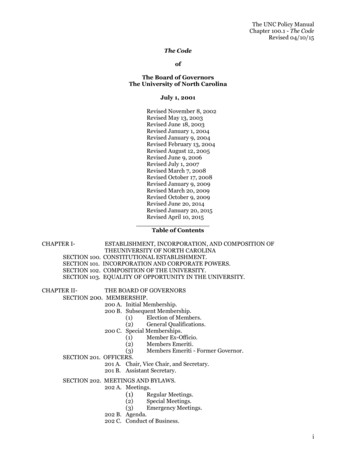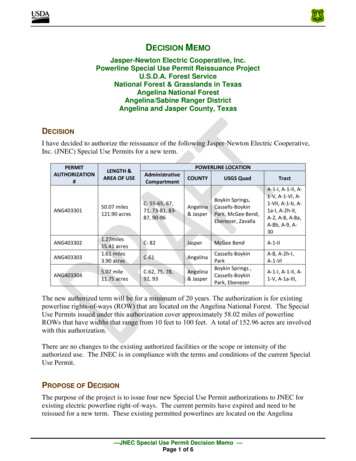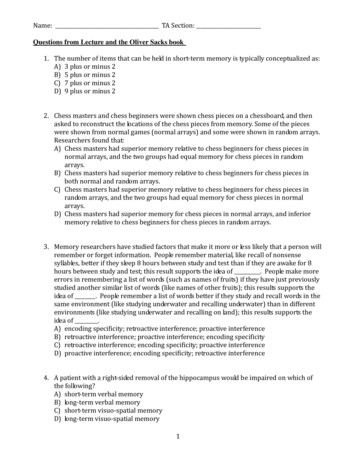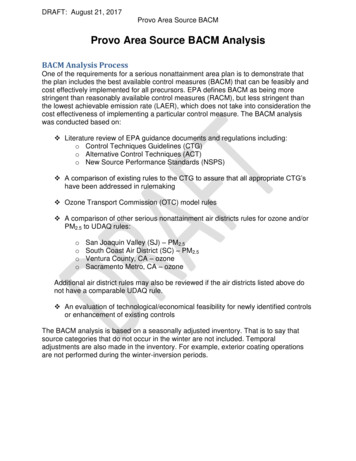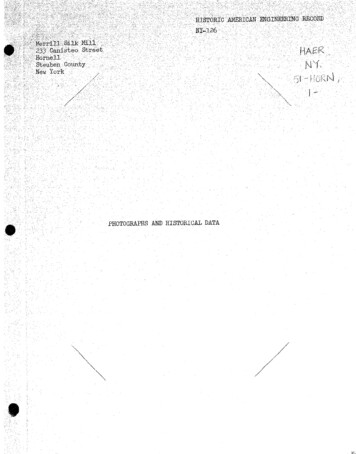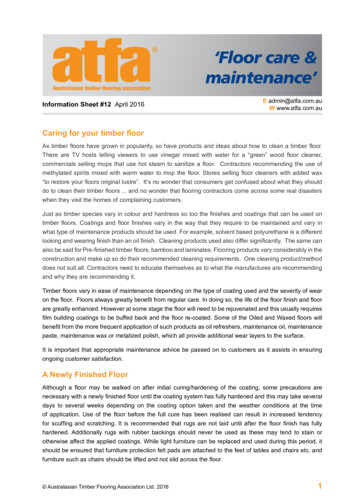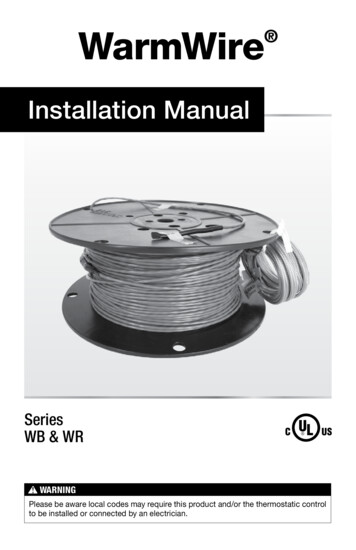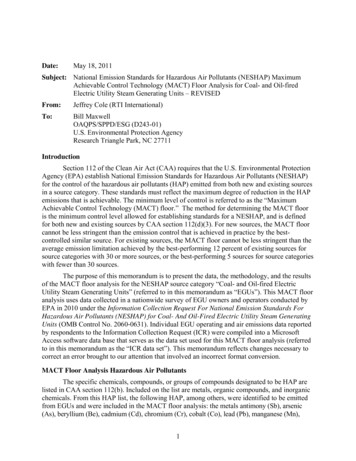
Transcription
Date:May 18, 2011Subject: National Emission Standards for Hazardous Air Pollutants (NESHAP) MaximumAchievable Control Technology (MACT) Floor Analysis for Coal- and Oil-firedElectric Utility Steam Generating Units – REVISEDFrom:Jeffrey Cole (RTI International)To:Bill MaxwellOAQPS/SPPD/ESG (D243-01)U.S. Environmental Protection AgencyResearch Triangle Park, NC 27711IntroductionSection 112 of the Clean Air Act (CAA) requires that the U.S. Environmental ProtectionAgency (EPA) establish National Emission Standards for Hazardous Air Pollutants (NESHAP)for the control of the hazardous air pollutants (HAP) emitted from both new and existing sourcesin a source category. These standards must reflect the maximum degree of reduction in the HAPemissions that is achievable. The minimum level of control is referred to as the “MaximumAchievable Control Technology (MACT) floor.” The method for determining the MACT flooris the minimum control level allowed for establishing standards for a NESHAP, and is definedfor both new and existing sources by CAA section 112(d)(3). For new sources, the MACT floorcannot be less stringent than the emission control that is achieved in practice by the bestcontrolled similar source. For existing sources, the MACT floor cannot be less stringent than theaverage emission limitation achieved by the best-performing 12 percent of existing sources forsource categories with 30 or more sources, or the best-performing 5 sources for source categorieswith fewer than 30 sources.The purpose of this memorandum is to present the data, the methodology, and the resultsof the MACT floor analysis for the NESHAP source category “Coal- and Oil-fired ElectricUtility Steam Generating Units” (referred to in this memorandum as “EGUs”). This MACT flooranalysis uses data collected in a nationwide survey of EGU owners and operators conducted byEPA in 2010 under the Information Collection Request For National Emission Standards ForHazardous Air Pollutants (NESHAP) for Coal- And Oil-Fired Electric Utility Steam GeneratingUnits (OMB Control No. 2060‐0631). Individual EGU operating and air emissions data reportedby respondents to the Information Collection Request (ICR) were compiled into a MicrosoftAccess software data base that serves as the data set used for this MACT floor analysis (referredto in this memorandum as the “ICR data set”). This memorandum reflects changes necessary tocorrect an error brought to our attention that involved an incorrect format conversion.MACT Floor Analysis Hazardous Air PollutantsThe specific chemicals, compounds, or groups of compounds designated to be HAP arelisted in CAA section 112(b). Included on the list are metals, organic compounds, and inorganicchemicals. From this HAP list, the following HAP, among others, were identified to be emittedfrom EGUs and were included in the MACT floor analysis: the metals antimony (Sb), arsenic(As), beryllium (Be), cadmium (Cd), chromium (Cr), cobalt (Co), lead (Pb), manganese (Mn),1
mercury (Hg), nickel (Ni), and selenium (Se); and the acid gases hydrogen chloride (HCl) andhydrogen fluoride (HF). In addition, MACT floor levels were analyzed using total particulatematter (PM) emissions as a surrogate pollutant for HAP metals other than Hg (non-Hg metallicHAP can be controlled with certain PM control devices), and using sulfur dioxide (SO2)emissions as a surrogate pollutant for HAP acid gases (HAP acid gases are also controlled byflue gas desulfurization systems used to control SO2).MACT Floor Analysis SubcategoriesUnder CAA section 112(d)(1), EPA has the discretion to “.distinguish among classes,types, and sizes of sources within a category or subcategory in establishing.” standards. Whenseparate subcategories are established, a MACT floor is determined separately for eachsubcategory. To determine whether the Coal- and Oil-fired Electric Utility Steam GeneratingUnits source category warrants subcategorization for the MACT floor analysis, EPA reviewedEGU design, operating information, and air emissions data compiled in the ICR data set andother information collected by the Agency for development of the NESHAP for this sourcecategory. Based on this review, EPA concluded that there are significant design and operationaldifferences in EGU designs affecting the levels of emissions of certain HAP to justify groupingEGUs by unit design within subcategories for the purpose of establishing MACT floors.The data available to EPA show that the levels of HAP emissions for EGUs burning solidcoal are the same for all of the HAP constituents except Hg. To account for the differences in Hgemissions from these units, EPA identified two subcategories for EGUs burning solid coal basedon unit design. The HAP emissions from integrated gasification combined cycle (IGCC) EGUsare distinct from EGUs burning solid coal because IGCC units burn a synthetic gas derived fromcoal. Consequently, a separate subcategory is defined for IGCC units. The data show differencesin all HAP emissions from oil-fired EGUs compared to coal-fired EGUs. Furthermore, there aredistinct differences in the HAP emissions levels from oil-fired EGUs depending on whether fueloil is burned or a petroleum-derived solid fuel is burned. Therefore, two separate subcategoriesare defined for oil-fired EGUs based on the physical state of the oil burned. For the MACT flooranalysis, the following five EGU subcategories were defined:Subcategory 1. New and existing EGUs designed to burn a coal having a calorificvalue (determined on a moisture and mineral matter-free basis) of greater than orequal to 8,300 British thermal units per pound (Btu/lb) in a unit with a furnaceheight-to-depth ratio of less than 3.82.1Subcategory 2. New and existing EGUs designed to burn a virginnonagglomerating coal having a calorific value (determined on moisture andmineral matter-free basis) of less than 8,300 Btu/lb in a unit with a furnace heightto-depth ratio of 3.82 or greater.1Subcategory 1 and Subcategory 2 were subcategorized for mercury emissions only. The remaining standardsproposed in this action are the same for the two subcategories.2
Subcategory 3. New and existing IGCC EGUs.Subcategory 4. New and existing EGUs that burn liquid oil.Subcategory 5. New and existing EGUs that burn solid oil-derived fuel.MACT Floor Analysis MethodologyThe first step in the MACT floor analysis for each subcategory and HAP or surrogatepollutant type was to rank all of the EGUs in the subcategory (for which there were emissionsdata in the ICR data set) for the pollutant type by emission level (lowest to highest). From thisranking, a MACT floor pool of sources was identified for determining the minimum control levelallowed for the MACT floor, consistent with the criteria defined for new and existing sources byCAA section 112(d)(3). For the new-source MACT floors, the best-controlled source wasidentified for which there were individual source test run data in the ICR data set. For theexisting-source MACT floors, selection of the MACT floor pool size (i.e., number of EGUs to beincluded in the determination of the average emission limitation value) was determined on anindividual subcategory basis as described below.Subcategory 1. The existing-source MACT floors for PM, HCl, SO2, total non-HgHAP metals, and individual non-Hg HAP metals emissions were based on the top12 percent of the total number of EGUs in the nationwide subcategory EGUpopulation (12 percent of 1,091 sources 131 EGUs). For the existing-sourceMACT floor determination for Hg, this subcategory only includes 1,061 sourcesbecause the other 30 sources are included in Subcategory 2. The existing-sourceMACT floor for Hg emissions was based on the top 12 percent of the totalnumber of the subcategory EGUs with Hg emissions in the ICR data set (12percent of 330 sources 40 EGUs). In the ICR, EPA indicated that it wasrequiring the best performing units selected for non-Hg metal HAP testing to alsotest for Hg because the test methods are similar for Hg and non-Hg HAP.Subcategory 2. This subcategory includes fewer than 30 sources. The EPA onlymade a subcategory distinction for Hg emissions from EGUs burning solid coal.The existing-source MACT floors for PM, HCl, SO2, total non-Hg HAP metals,and individual non-Hg HAP metals emissions were based on the same MACTfloor data pool used for Subcategory 1. The existing-source MACT floor for Hgemissions was based on the top two EGUs of the subcategory EGUs in the ICRdata set.Subcategory 3. This subcategory includes two sources (a third source currently isunder construction). The existing-source MACT floors for all HAP and surrogatepollutant emissions were based on the data for both IGCC EGUs in thesubcategory.Subcategory 4. This subcategory includes 154 sources and the ICR data setincludes data from 58 of those sources. The existing-source MACT floors for allHAP and HAP surrogates emissions were based on the top 12 percent of the totalnumber of the subcategory EGUs in the ICR data set (12 percent of 58 sources 7EGUs).Subcategory 5. This subcategory includes 10 sources and the ICR data set3
includes data from 7 of those sources. The existing-source MACT floors for allHAP and HAP surrogates were based on the top five EGUs of the subcategoryEGUs in the ICR data set.The next step in the MACT floor analysis was to incorporate data variability into thecalculations of the applicable MACT floor limits for the subcategories using the data’s 99percent upper prediction limit (UPL). Specifically, the MACT floor limit is an UPL calculatedwith the Student’s t-test using the “TINV” function in Microsoft Excel software. The Student’s ttest has also been used in other EPA rulemakings (e.g., NESHAP for Portland Cement, NSPS forHospital/Medical/Infectious Waste Incinerators, NESHAP for Industrial, Commercial, andInstitutional Boilers and Process Heaters) in accounting for variability and reflects the level ofconfidence. The level of confidence represents the level of protection afforded to facilities whoseemissions are in line with the best performers, and consequently, the level of confidence is notarbitrary. For example, a 99 percent level of confidence means that a facility whose emissionsare in line with the best performers has one chance in 100 of exceeding the floor limit. Aprediction interval for a single future observation (or an average of several test observations) isan interval that will, with a specified degree of confidence, contain the next (or the average ofsome other pre-specified number) of randomly selected observation(s) from a population. Inother words, the UPL estimates what the upper bound of future values will be, based uponpresent or past background samples taken. The UPL consequently represents the value at whichwe can expect the mean of future observations for the HAP or HAP surrogate emissions to fallwithin a specified level of confidence, based upon the results of an independent sample from thesame population. This formula encompasses all the data point to data point variability. Itspredictions derive from the data set to which it is applied, and thus can be applied to any type ofdata.The form of the equation differs somewhat depending upon the nature of the data set towhich it is applied. To this end, the data sets were evaluated for each HAP and HAP surrogate toascertain whether the data were normally distributed, or distributed in some other manner (i.e.,log normally). For data sets where the number of available EGUs was 15 or more, use of theUPL was based on assuming a normal distribution based on the Central Limit Theorem (Durrett,1996). The Central Limit Theorem states that regardless of the shape of the original distribution,if the distribution has a finite mean (μ) and variance (σ²), the sampling distribution of the meanapproaches a normal distribution with a mean of (μ) and a variance of σ²/N as N, the samplesize, increases (Durrett, 1996).When the sample size is smaller than 15 and the distribution of the data is unknown, theCentral Limit Theorem cannot be used to support the normality assumption. Statistical test of thekurtosis, skewness, and goodness of fit test are then used to evaluate the normality assumption.The skewness statistic (S) characterizes the degree of asymmetry of a given data distribution.Normally distributed data have an S value of 0. An S value that is greater (less) than 0 indicatesthat the data are asymmetrically distributed with a right (left) tail extending towards positive(negative) values. Further, the standard error of the skewness statistic (SES) can beapproximated by SES SQRT(6/N) where N is the sample size. According to the small sampleskewness hypothesis test, if the S value is greater than two times the SES, the data distributioncan be considered non-normal. The kurtosis statistic (K) characterizes the degree of peakednessor flatness of a given data distribution in comparison to a normal distribution. Normallydistributed data have a K value of 0. A K value that is greater (less) than 0 indicates a relatively4
peaked (flat) distribution. Further, the standard error of the kurtosis statistic (SEK) can beapproximated by SEK SQRT(24/N) where N is the sample size. According to the small samplekurtosis hypothesis test, if the K value is greater than two times the SEK value, the datadistribution is typically considered to be non-normal.For each data set to which the UPL was applied (i.e., the separate data sets for each HAPand HAP surrogate type applicable to the subcategory), the S and K values were calculated usingboth the reported test values and the log-transformed reported test values. If the S and K valuesstatistics of the reported data set were both less than twice the SES and SEK, respectively, thedataset was classified as normally distributed. If neither of the S and K values, or only one ofthese statistical values were less than twice the SES or SEK, respectively, then the skewness andkurtosis hypothesis tests were conducted for the natural log-transformed data. If the S and Kvalues of the log-transformed reported data set were both less than twice the SES and SEK,respectively, the log-transformed dataset was classified as normally distributed and an equationto calculate the floor using an UPL equation for log-normal data was then used (Bhaumik andGibbons, 2004). If both the reported values and the natural-log transformed reported values hadS and K values that were greater than twice the SES or SEK, respectively, the normallydistributed dataset was selected as the basis of the floor to be conservative. If the results of theskewness and kurtosis hypothesis tests were mixed for the reported values and the natural logtransformed reported values, the normal distribution was chosen to be conservative. Thisapproach is more accurate and obtained more representative results than a more simplisticnormal distribution assumption.Specifically, in the case of normal distributed data, the MACT floor limit is an UPLcalculated as: 1 1 UPL x tdf ,.99 s 2 n m Where:1 N ni mean of the top performing sources calculated as x xijn i 1 j 1Nn Number of test runs ni 1im Number of future test runs in the compliance averageN Number of sources2s pooled variance calculated as21 ns xi X n 1 i 12t df, 99 99th – quantile of t-distribution with df degrees of freedom N df ni 15 i 1
df degrees of freedom calculated asThis calculation was performed using the following Excel functions:Normal distribution: 99th Confidence UPL AVERAGE(Test Runs in Top 12%) [STDEV(Test Runs in Top 12%) x TINV(2 x probability, n-1 degrees offreedom)*SQRT((1/n) (1/m))], for a one-tailed t-value, probability of 0.01, and samplesize of n.The 99th confidence UPL was selected as a reasonable upper limit because only 1 percentof future tests of the MACT pool of lowest emitting EGUs will exceed the limit if they areperforming as well as the emission test data indicate (i.e., these EGUs will be below or achievethe limit 99 percent of the time in the future). If variability was not accounted for in this mannerand a limit was set based solely on the average performance, then these EGUs could exceed thelimit half the time or more.For some data sets, a single floor average per source or unit was available; analysis basedsolely in these single per unit observations will not reflect any possible within-source variability.In cases where additional available emissions data from past years was available, it was decidedto incorporate these data in the estimation of the variance term, s2, allowing for consideration ofwithin- and between-source variability. The most recent data (e.g., single floor average) wereused to calculate the average in the UPL equation. The UPL equation for this case is calculatedas: 1 1 UPL x tdf ,.99 s 2 N m Where:m Number of future test runs in the compliance averageN Number of units involved in calculating the average (a single measurement (e.g., flooraverage) per unit)ni Number of data points (e.g., stack averages) collected in the past for the i-th sourceNn N nii 1xi Current information (e.g., single floor average) for the i-th sourceyi Past information (e.g., stack average) for the i-th source6
x mean of the top performing sources calculated as x 1NN xi 1ix grand mean (mean of the current and past information from the top performing sourcesx N ni 1 N x i yi n i 1i 1 j 1 s2 variance calculated as s 2 N ni2 21 N xxyij x i n 1 i 1i 1 j 1 t df, 99 99th quantile t-distribution with df degrees of freedomdf Degrees of freedom n -1The calculation of this UPL was performed using the following Excel function:Normal distribution: 99% UPL AVERAGE (Test Runs in Top 12%) [STDEV(TestRuns in Top 12%,stack averages) x TINV(2 x probability, (n-1) degrees offreedom)*SQRT((1/N) (1/3))], for a one-tailed t-value (with 2 x probability), probabilityof 0.01, and sample size of n.The UPL, to test compliance based on a 3-run average and assuming log-normal data, iscalculated by the following equation (Bhaumik and Gibbons, 2004):UPL e2 ˆ ˆ2 z.99m222 ˆ2 ˆ 4 me 2 ˆ ˆ (e ˆ 1) m 2 e 2 ˆ ˆ n 2( n 1) Where: ˆ ni 1log yi the average of the log transformed data from the top performing sourcesn log y ˆ n ˆ2i 1in 12the variance estimate of the log transformed data from the topperforming sourcesz.99 is the 99th-percentile of the log-normal distribution estimated using the trapezoidal ruleapproach from the following equation:7
z.990 2 z 3 3 6 z 2 z 4 1z3 1 ( z ) .99 3z z 624 The calculation of this log-normal based UPL was performed using the following Excelfunction:Normal distribution: 99% UPL EXP(AVERAGE(LN(Test Runs in Top 12%)) VAR(LN(Test Runs in Top 12%))/2) (99TH-PERCENTILE LOGNORMAL DISTRIBUTION/m)*SQRT(m*EXP(2* AVERAGE(LN(Test Runs in Top 12%)) VAR(LN(Test Runs in Top12%)))*(EXP(VAR(LN(Test Runs in Top 12%)))-1) m 2* EXP(2* AVERAGE(LN(Test Runs in Top 12%)) VAR(LN(Test Runs in Top12%)))*( VAR(LN(Test Runs in Top 12%))/n VAR(LN(Test Runs in Top 12%)) 2/(2*(n1)))The 99th percentile of the log-normal distribution was calculated following Bhaumik andGibbons (2004).Adjustment for Below Detection Level Emissions DataTo account for the effect of measurement imprecision associated with a data base thatincludes method detection level data, a protocol specified by EPA was used. The first step was todefine a method detection level that is representative of the data for a given HAP or HAPsurrogate used in establishing the MACT floor emissions limit and that also minimizes theinfluence of an outlier test-specific method detection level value. Each pollutant-specific data setwas reviewed to identify the highest test-specific method detection level reported that was alsoequal to, or less than, the average emissions level (i.e., unadjusted for probability confidencelevel) calculated for the data set. This approach is representative of the data collected to developthe MACT floor emissions limit while to some degree minimizing the effect of a test(s) with aninordinately high method detection level (e.g., the sample volume was too small, the laboratorytechnique was insufficiently sensitive, or the procedure for determining the detection level wasother than that specified).The second step is to calculate three times the representative method detection level andcompare that value to the calculated floor or emissions limit. If three times the representativemethod detection level was less than the calculated floor or emissions limit calculated from theUPL, it was concluded that measurement variability was adequately addressed. The calculatedMACT floor emission limit would need no adjustment. If, on the other hand, the value equal tothree times the representative method detection level was greater than the UPL, it was concludedthat the calculated MACT floor emissions limit does not account entirely for measurementvariability. If indicated, we substituted the value equal to three times the representative methoddetection level to apply as the adjusted floor or emissions limit. This adjusted value would ensuremeasurement variability is adequately addressed in the floor or the emissions limit. This checkwas part of the variability analysis for all new MACT floors that had below detection level(BDL) or detection level limited (DLL) run data present in the best-controlled data set. Belowdetection level data are emissions data where all analytical values used to calculate and report anin-stack emissions value are less than the laboratory’s reported detection level(s). Detection level8
limited data are emissions data where at least one but not all values used to calculate and reportan in-stack emissions value are less than the laboratory’s reported detection level(s). Forreference purposes, above detection level (ADL) data are emissions data where all analyticalvalues used to calculate and report an in-stack emissions value are greater than the laboratory’sreported detection level(s). The review cited above only resulted in the new MACT floors beingthree times the MDL rather than the UPL for the following limits:Subcategory 1 - Coal: HCl, HFSubcategory 3 - IGCC: HClSubcategory 4 - Liquid Oil: HCl, HF, Be, CdMACT Floor Analysis Data SetIn determining MACT floors for the pollutant emissions from coal-fired EGUs other thanIGCC EGUs (Subcategories 1 and 2), the MACT floor calculations for PM, SO2, total non-HgHAP metals, individual HAP metals other than Hg, HCl, and Hg used the single lowest emissionaverage reported for a pollutant for each EGU in the MACT floor pool. The variability analysisincluded other pollutant-specific test emission averages from data collected from the required2010 ICR emissions testing (Part III of the 2010 ICR) and the applicable emissions data reportedby the respondents for tests performed within the last 5 years (Part II of the 2010 ICR). This wasdone for the purpose of showing variability of emissions in testing at a unit over time. Theseadditional data were filtered so that only those data from emissions tests with the same pollutantcontrol configurations were included. For example, a company supplies Hg emissions Part II testdata (i.e., test data from 1/1/2005 through 12/31/2009) for a unit from every year from 2005 to2009 under the ICR. The ICR data also shows that that company installed an ACI system and afabric filter that both went online in December of 2007, and the controls present as of that date atthat unit are the same controls that the unit had during the 2010 ICR. In this case, only the Part IItest data for Hg emissions tested on or after 12/2007 through 12/2009 was used in the MACTfloor variability calculation. Also, the newer and older emission average data within thesefiltered constraints were given the same weight as far as which could be chosen as the lowestemission point. For example, if a data point from an earlier 2008 Hg emissions test for a givenEGU showed a lower emission level than the data point from a 2010 ICR required emissions test,the lower emission average was used for the MACT floor calculations with the 2010 ICR datapoint and any other test data reported for the EGU used to show variability over time.Three HCl data points were excluded from the data set used to calculate the HCl emissionlevel MACT floors for coal-fired EGUs other than IGCC EGUs (Subcategories 1 and 2). Twosingle data points expressed as lb/MMBtu HCl emission averages were approximately two ordersof magnitude greater than the minimum value for the given unit. These data were from olderfacility tests (not tests required to be performed by the 2010 ICR) for which only emissionaverages were reported. Without run level data it is not possible to determine whether theseaverages represent valid test values or were calculated incorrectly. Also, a third single data pointexpressed as a lb/MW emission average was approximately two orders of magnitude greater thanthe minimum value for the given unit and was excluded for the same reasoning.Two data points were excluded from the data set used to calculate the Hg emission levelMACT floors for Hg emissions from coal-fired EGUs other than IGCC EGUs (Subcategory 1).Both data points, expressed as lb/MMBtu Hg emission averages, were approximately two orders9
of magnitude or greater than the minimum value for the given unit. Both of these data pointswere from older facility tests for which only emission averages were reported without thecorresponding run-level data.Three companies operating five of the oil-fired EGUs required to perform emissionstesting by the 2010 ICR requested permission from EPA to continue their normal operatingpractice of co-firing No. 6 residual fuel oil with natural gas while conducting their testing inorder to meet the ICR reporting deadline. The emissions data reported for these EGUs were notincluded in the data set used for Subcategory 4 MACT floor calculations because their emissionsare not representative of EGUs firing 100 percent fuel oil.The MACT floors for new sources are based on the emission control that is achieved inpractice by the best-controlled source in a subcategory. In determining the new-source MACTfloors for the pollutant emissions from coal-fired EGUs other than IGCC EGUs (Subcategories 1and 2), there were situations for some pollutants where only an emission average and noindividual run-level data were available for the EGU identified as the best-controlled source forthe given pollutant. In these cases, no emission variability could be determined based on a singledata point. Therefore, the next best-controlled source with individual test run data was used todetermine the new-source MACT emissions level as presented in Table 1.MACT Floor Analysis ResultsTables 2, 3, 4, and 5 present the new-source and existing-source MACT floor valuesdetermined for the Coal- and Oil-fired Electric Utility Steam Generating Unit source category.Attachments A through D present the summary tables with mean, UPL, and floor values for newand existing sources, the ranked emission data for MACT floor analysis, and examples of theUPL calculations for existing sources and new sources. The data points removed due to beingoutliers are shown in Attachment E to this memorandum.ReferencesBhaumik, D.K. and Gibbons, R.D. 2004. An Upper Prediction Limit for the Arithmetic Meanof a Lognormal Random Variable. Technometrics, 46(2):239-248.Durrett, Richard (1996). Probability: Theory and Examples (Second edition).10
Table 1. Coal-fired EGU New-Source MACT Floor Data Set SubstitutionsPollutantHgChromiumSO2,Total PMTotal non-HgHAP MetalsData Set SubstitutionCould not use the data for either Spruance Genco, LLC (ORIS 54081) Gen 2 orGen 3 as both are of a unique size and design that most likely will not berepresentative of newly built units. Therefore, the run-level data for Nucla Unit 001(ORIS 527) was used.Could not use the data for Dallman Unit 34 (ORIS 963) as no run-level data wereavailable; used the run-level data for Cholla Unit 3 (ORIS 113).Could not use the data for Stanton Unit 10 (ORIS 2824) as no run-level data wereavailable; used the run-level data for Port of Stockton District Energy Facility Unit1 (ORIS 54238).Could not use the data for Bonanza Power Plant Unit 1-1 (ORIS 7790) as no runlevel data were available; used the run-level data for Dunkirk Generating Plant Unit1 (ORIS 2554).Could not use the data for Chambers Cogeneration L.P. Boiler 2 (ORIS 10566) asno run-level data were available; used the run-level data for Weston Unit 4 (ORIS4078).11
Table 2. Summary of Existing Sources MACT Floor Results for Hg and Non-Hg Metal HAPSubcategory123ParameterNo. in MACT floor99% UPL of top 12% (i.e., MACT floor;except where noted)No. in MACT floor99% UPL of top 12% (i.e., MACT floor;except where noted)No. in MACT floor99% UPL (i.e., MACT floor)No. in MACT floor499% UPL of top 12% (i.e., MACT floor)No. in MACT floor5Subcategory99% UPL of top 5 (i.e., MACT floor)23Cadmium (Cd)1310.3 lb/TBtu0.003 lb/GWh1310.3 lb/TBtu0.003 lb/GWh20.2 lb/TBtu0.002 lb/GWh70.1 lb/TBtu0.002 lb/GWh50.4 lb/TBtu0.004 lb/GWhChromium (Cr)1313 lb/TBtu0.03 lb/GWh1313 lb/TBtu0.03 lb/GWh23 lb/TBtu0.02 lb/GWh72 lb/TBtu0.02 lb/GWh52 lb/TBtu0.02 lb/GWhNickel (Ni)Selenium (Se)131131131131Total Non Hg HAPMetals13199% UPL of top 12% (i.e., MACT floor;except where noted)2 lb/TBtu0.02 lb/GWh5 lb/TBtu0.05 lb/GWh4 lb/TBtu0.04 lb/GWh6 lb/TBtu0.06 lb/GWhNo. in MACT floor99% UPL of top 12% (i.e., MACT floor;except where noted)No. in MACT floor1312 lb/TBtu0.02 lb/GWh20.0002 lb/MMBtu3 lb/GWh72 lb/TBtu0.03 lb/GWh511 lb/TBtu0.02 lb/GWh1315 lb/TBtu0.05 lb/GWh23 lb/TBtu0.02 lb/GWh75 lb/TBtu0.06 lb/GWh53 lb/TBtu0.04 lb/GWh1314 lb/TBtu0.04 lb/GWh25 lb/TBtu0.05 lb/GWh78 lb/TBtu0.08 lb/GWh59 lb/TBtu0.09 lb/GWh1316 lb/TBtu0.06 lb
distinct differences in the HAP emissions levels from oil-fired EGUs depending on whether fuel oil is burned or a petroleum-derived solid fuel is burned. Therefore, two separate subcategories are defined for oil-fired EGUs based on the physical state of the oil burned. For the MACT floor analysis, the following five EGU subcategories were defined:
